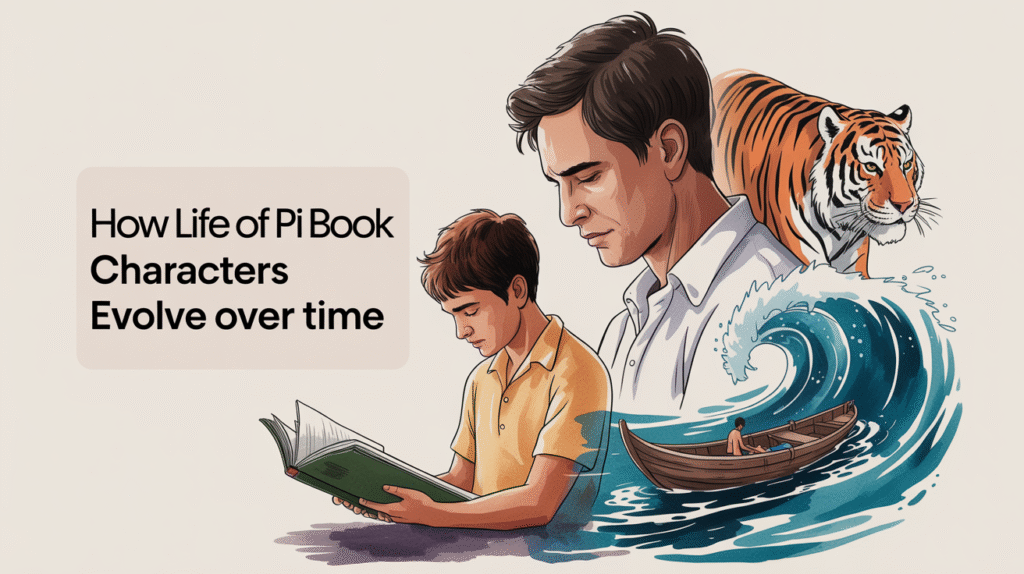The characters in Life of Pi, especially Pi Patel, experience profound personal growth that reflects the book’s deeper themes of survival, belief, and transformation. These character arcs are crucial in understanding the novel’s psychological and philosophical depth.

Let’s explore how Pi and others evolve throughout the narrative—and why their development matters to the story’s overall impact.
Pi Patel’s Character Arc: From Innocence to Enlightenment
Pi is the heart of the story. His transformation during his journey across the Pacific Ocean defines the emotional and philosophical trajectory of the novel.
Early Life: The Curious Believer
- Pi starts as a deeply curious boy raised in a zoo, fascinated by religion and science.
- His desire to practice Hinduism, Christianity, and Islam showcases an early openness to multiple perspectives.
The Journey: Forced Maturity and Survival Instinct
- After the shipwreck, Pi transitions from a passive thinker to an active survivor.
- He learns to fish, builds a raft, and coexists with Richard Parker—his transformation is physical, mental, and spiritual.
After the Journey: Reflection and Wisdom
- Pi’s later narration reveals his growth into a thoughtful adult who views life with philosophical clarity.
- He’s no longer just a boy with questions—he becomes a man with profound insights about belief and truth.
Richard Parker: More Than Just a Tiger
Richard Parker, the Bengal tiger, plays a unique role in Pi’s transformation and survival.
Survival Symbol and Emotional Anchor
- Richard Parker keeps Pi alert and gives him purpose, preventing mental collapse.
- The need to care for and coexist with a predator forces Pi to harness courage and discipline.
A Mirror of Pi’s Inner Self
- Many interpret the tiger as a projection of Pi’s primal instincts.
- Richard Parker’s sudden disappearance on land symbolizes the end of Pi’s survival-driven persona.
Supporting Characters That Shape Pi
While Pi’s journey is largely solitary, several secondary characters have lasting influence on his development.
Pi’s Father: A Voice of Reason and Responsibility
- Teaches Pi to respect animal instincts and understand danger—a lesson that saves his life later.
- His scientific outlook shapes Pi’s balanced view between faith and reason.
The Religious Mentors: Multiplying Perspectives
- A Hindu pandit, a Christian priest, and a Muslim imam help Pi build a multi-faith identity.
- Their conflict over Pi’s simultaneous devotion to different religions highlights society’s discomfort with religious pluralism.
The Cook and the Sailor: In the Brutal Version of the Story
- In the darker, more realistic interpretation of the journey, these characters reflect the harshness of human nature.
- Their inclusion adds psychological complexity and makes the reader reevaluate Pi’s experiences.
Character Growth Through Crisis
Extreme conditions catalyze growth. Life of Pi demonstrates how adversity transforms characters—especially the protagonist.
Growth Rooted in Suffering
- Every element of Pi’s suffering—from losing family to facing starvation—forces him to evolve.
- His growth is not linear but reflective of real human development: messy, spiritual, and often contradictory.
From Fear to Faith
- Pi’s journey takes him from a fearful boy to a spiritually enlightened narrator.
- Even as he endures suffering, he never abandons faith; instead, he redefines it.
Thematic Resonance of Character Arcs
Character development in Life of Pi supports the book’s philosophical undertones.
Identity and Adaptation
- Pi’s ability to shift roles—from student to survivor to storyteller—illustrates the fluid nature of identity.
- His mental agility is just as critical to his survival as his physical endurance.
Truth, Belief, and Story
- Characters are not just people; they are vessels for ideas.
- Their arcs challenge readers to question reality, belief systems, and the role of narrative in understanding truth.
FAQ: Character Arcs and Growth in Life of Pi
Here are some questions and answers about the character development in Life of Pi.
How does Pi change throughout the story?
Pi transforms from a curious, faith-driven boy into a hardened, resourceful survivor. By the end, he becomes a reflective adult who uses storytelling to process trauma and make sense of life’s contradictions.
Why is Richard Parker important to Pi’s development?
Richard Parker symbolizes Pi’s survival instincts and inner strength. Caring for the tiger gives Pi purpose and helps him stay mentally stable during his time at sea.
Are the supporting characters in Life of Pi significant?
Yes, they shape Pi’s worldview and philosophical growth. His father instills respect for nature, while religious mentors expand his understanding of spirituality. Even briefly seen characters influence his long-term evolution.
What do the character arcs say about the book’s themes?
The arcs reflect key themes like survival, belief, identity, and the power of storytelling. Each character’s evolution highlights different facets of these broader messages.
Does Pi grow emotionally or just physically?
Both. Pi’s physical endurance is matched by emotional maturity and spiritual insight. His survival is not just a matter of staying alive—it’s about redefining how to live.
Life of Pi uses character development as a powerful tool to explore deep, often spiritual questions. By examining how its characters grow and change, readers gain insight into their own beliefs about truth, faith, and the human spirit.
